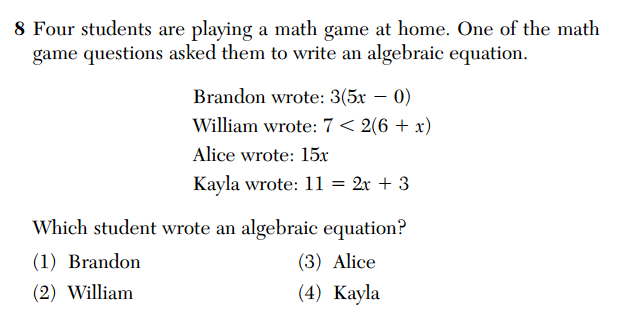Regents Recap — January 2015: Not Even Pseudo-Context
Here is another installment in my series reviewing the NY State Regents exams in mathematics.
This is question 8 from the Integrated Algebra exam.
 “Four students are playing a math game at home. One of the math game questions asked them to write an algebraic equation.“
“Four students are playing a math game at home. One of the math game questions asked them to write an algebraic equation.“
The context of this question is utterly absurd The question might as well have been
“Four students are taking a math test. One of the questions asked them to write an algebraic equation. Which student answered the test question correctly?”
Why not just ask “Which of the following is an example of an algebraic equation?”. Maybe there are people who believe that framing questions as games, or humanizing them, will engage test-takers more, but it’s hard to believe that contrivances like this do anything but further separate students from the concepts they purport to assess. This is another example of the negative impact these poorly-designed tests can have on students, which I discuss at length in my talk “g=4, and Other Lies the Test Told Me“.
Math teachers are familiar with the notion of pseudo-context, but I’m not sure what I would call this. Meta-pseudo-context? Pseudo-meta-context? Pseudo-pseudo-context? Ridiculous, at the very least.
Related Posts
9 Comments
Fung · March 8, 2015 at 9:42 am
Interesting, I’ve never thought of why the problem creator made the question the way he/she did…
L. Francisco · March 10, 2015 at 12:44 am
Here’s one from my son’s 5th grade math book:
Class A folds 160 fewer paper cranes than Class B and 2/3 as many as Class C. Class B folds 92 more paper cranes than Class C. How many paper cranes does Class B fold?
At this point I’m thinking “who cares?” A friend said that she wouldn’t know because she would be too busy folding paper cranes herself.
It just makes me wonder what the ultimate goal of this question is. Does it really need to be that detailed and complicated? I know everything is working toward being “real world centered” but this problem does not seem very real world to me.
Jerome Dancis · March 28, 2016 at 5:36 pm
This problem appears at
http://brainly.com/question/196483.
Its solution begins:
Let x = Class A
Let y = Class B
Let z = Class C
Equations from problem:
x – 160 = y
2/3x = z
y + 92 = z
All 3 Equations from problem are wrong.
Answer 44 paper cranes in class B, is clearly wrong. Since Class A folds 160 fewer paper cranes than Class B, clearly Class B must have at least 160 paper cranes.
Of course, for a Grade 5 class, students do not know Algebra.
An Arithmetic solution can be easily obtained using the Singapore Math bar diagrams. See
“Solving Algebra and Other Story Problems with Simple Diagrams: a Method Demonstrated in Grade 4–6 Texts Used in Singapore” by Sybilla Beckmann, a mathematician at the University of Georgia. Find this report at
http://math.coe.uga.edu/tme/issues/v14n1/v14n1.Beckmann.pdf
G · March 29, 2016 at 10:32 am
You mean x+160 = y.
gg · March 29, 2016 at 7:50 pm
Did you notice the fact that this was a quote and his comment that “All 3 Equations from problem are wrong”?
R Ames · September 12, 2017 at 11:49 am
What’s really strange is that you couldn’t know that A folded 160 fewer than B unless you already knew how many B folded, or that 160 was only 2/3 of C’s total unless you already knew how many C folded.
It’s not a problem, it’s a puzzle: Here are some clues; can you figure out what number I’m thinking of? Are you thinking what I’m thinking?
Ben Orlin · March 15, 2015 at 12:34 pm
Why stop the nesting of pseudo-context there?
“8. A child is watching a film, in which a person reading a book encounters a description of an eighth-grader taking a Regents exam, whose final question refers to four students playing a math game at home…”
Jerome Dancis · March 28, 2016 at 5:15 pm
These overly wordy problems provide a big advantage to speed readers. They put slow readers at a disadvantage. My game-the-test advice: Skip the opening paragraph. You may need the time saved to finish the test.
Adam Epstein · March 30, 2016 at 6:11 pm
Imagine all the hours of committee time spent making sure that the chosen correspondence between names and answers did not reflect unconscious bias of a demographic nature, all the money to be made by test prep academies teaching how to thereby game such problems, not to mention various higher order epiphenomena.